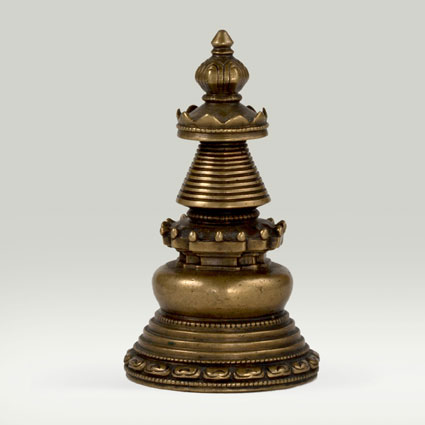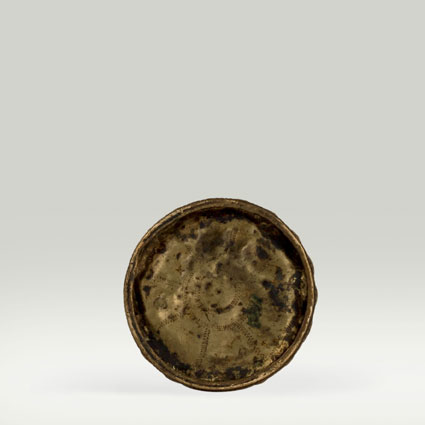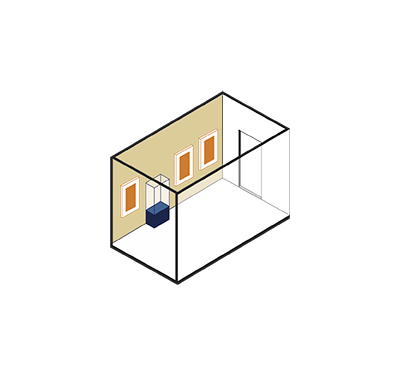ABR 021
Code: ABR 021
Country: Tibet (central)
Style:
Date: 1150 - 1350
Dimensions in cm WxHxD: 6.6 x 11.8 x 6.5
Materials: Brass
Hollow cast in one piece.
The bottom of the Stupa is sealed with a brass plate decorated with with a wheel (cakra).
Type of stupa – Location– Event - Shape
I - Padmakataka Stupa – Lumbini – Birth- circular, with lotus petals
(Tib. Pad spungs mchod rten)
II - Mahabodhi Stup – Bodhgaya - Victory over Mara- square, with four steps
(Tib. Byang chub mchod rten) - (maravijaya)
III- Bahudvara Stupa– Sarnath - First sermon- square, with four doors
(Tib. sGo mang mchod rten) - (dharmacakra pravartana)
IV - Pratiharya Stupa – Sravasti – Miracles- square, with a porch
(Tib. Cho ‘phrul mchod rten) - (mahapratiharya or yamakapratiharya)
V - Devavatara Stupa – Sankasya - Descent from- square, with four stairs
(Tib. lHa babs mchod rten) Trayastrimsa
VI - Antaryana Stupa – Rajagrha - Elephant taming- octagonal
(Tib. dByen dzlum mchod rten)
VII - Vijaya Stupa – Vaisali - Gift of honey- circular, tree-stepped
(Tib. rNam rgyal mchod rten)
VIII - Mahaparinirvana Stupa – Kusinagara – Death- cupola, without steps
(Tib. bKa’ gdams mchod rten, Myang ‘das mchod rten) - (mahaparinirvana)
The Mahaparinirvana Stupa (Tib. bKa’ gdams mChod rten) commemorates the death (mahaparinirvana)of the historical Buddha Shakyamuni at Kusinagara (modern Kasia, District Deoria, Uttar Pradesh, North India).
With the worship of stupas in early Buddhism the practice of pilgrimage to the four great places in the life of Buddha Shakyamuni became popular. These four locations were Lumbini (District Bhairwah, Terai, Nepal), the birth-place of Buddha Shakyamuni; Bodhgaya (District Gaya, Bihar), the location of Shakyamuni’s victory over Mara (maravijaya) and subsequent enlightenment under the asvattha tree; the Deer Park (Esipatana Mrgadava)at Sarnath (District Varanasi, Uttar Pradesh), the location of Shakyamuni’s first sermon known as setting the wheel of the Dharma in motion(dharmacakra pravartana); and Kusinagara (modern Kasia, District Deoria, Uttar Pradesh), the site of Shakyamuni’s mahaparinirvana. Later the pilgrimage was extended to the “eight great places” (astamahasthana), where Shakyamuni’s “eight great miracles”(astamahapratiharya)took place. The four additional locations were at the Jetavana monastery at Sravasti (District Gonda, Uttar Pradesh), where the “great illusion” (mahapratiharya), also known as “illusion of the twins” (yamakapratiharya) took place; Sankasya (modern Sankissa, District Farrukhabad, Uttar Pradesh), the site of Shakyamuni’s descent from the Trayastrimsa heaven (devarohana); Rajagrha (District Patna, Bihar), the place of Shakyamuni’s taming of the wild elephant Nalagiri; and Vaisali (modern Basarh, District Muzaffarpur, Bihar), where Shakyamuni received the gift of honey by one of the monkey at the Monkey’s Pond.
Giuseppe Tucci wrote a very scholarly piece on stupas I was given many years ago. In the interests of simplicity (and avoiding copyright infringements) it is distilled as follows:
“There are two reasons stupas were built after the historical Buddha Shakyamuni died:
* To commemorate eight great deeds accomplished during his life
* To enshrine relics after he passed away.”
The Eight Great Deeds
1. Birth: Built at Lumbini
2. Enlightenment: Built in the kingdom of Magadha, on the banks of the river Nairanjana
3. Turning of the Wheel, the first teaching: Built at Sarnath (Varanasi)
4. Miracles: Built at Sravasti
5. Descent from Tushita: Built at Samkashya after Buddha returned from Tushita heaven, where he'd gone to give teachings to his mother
6. Reconciliation: Built at Rajagriha, after Buddha reconciled the disagreements of the monks
7. Complete Victory: Built at Vaishali, where Buddha meditated extensively
8. Parinirvana: Built at Kushinagara where Buddha entered mahaparinirvana
Enshrining Relics
When he ended his earthly life, and his mortal remains were cremated, his ashes - thus it has been said - were divided into eight parts which were closed up and protected by the princes and communities. Or ten, or eleven, according to different traditions. More stupas were built over these relics. Of the really old stupas still intact today, most are said to contain relics of the Buddha.
In Tibet, the construction of stupas (mchod-rten, pronounced chor-ten) came to be an intregal part of the spiritual life. The symbolism is so vast and complex it is slightly rediculous to attempt any simplification of it. Every part of the outwardly visible stupa has specific significance, yet this is only the surface: within are scriptures and relics in defined positions, each equally alive with symbolic meaning.
To start at the very beginning: generosity is the first of the 10 perfections, and within the different catagories of giving, none is higher than the giving of Dharma (sometimes translated as Law or Truth). As the stupa represents the enlightened mind, the person who contributes to the construction..."who gives, who sacrifices something of his wealth, of his person or of his very desires, makes an act of renunciation and succeeds, at least in that very moment, in putting others before himself." (Tucci)
So, in building a stupa, or contributing in any way towards one, is considered a “good thing” by Buddhists in general. It is a structure that invites (or even invokes) peace.
Not being a very structured person, here's a cheerful mixing up the discussion of history, art, symbolism and the benefits of stupas:
Robert Thurman / Denise Leidy say: "Stupas began in pre-Buddhist India as hemispherical burial grounds that marked the remains of temporal rulers. At an early stage in the development of Buddhist art, they became symbols of the Buddha's continuing immanance as well as representations of his mind........the fourteen rings around the spire (that are seen in all "modern" stupas) are all that remainn of the royal umbrellas often found in earlier stupas. They symbolise the fourteen stages traversed in the attainment of buddhahood; the four tantric stages added to the ten bodhisattva stages." (This quote is from "Mandala The Architecture of Enlightenment", by Denise Leidy and Robert Thurman.
Amoungst my collection of stupa stuff is an untitled section of symbolism which starts with this quote from His Holiness Dilgo Khyentse, Rinpoche:
"This stupa is called a dharmakaya stupa. Within it, the guru dwells unchanging. The Buddha said that whoever sees a dharmakaya stupa will be liberated by the sight of it. Feeling the breeze nearby the stupa liberates one by its touch. The sound of the tinkling of the small bells hanging on the stupa liberates one by their sound. having thus seen or experienced this stupa, by thinking of one's experience of it, one is liberated through recollection."
The piece continues:
"The stupa that enshrines the teacher's physical remains is at once a reminder of the teacher and the embodiment of the pure and all-pervasive aspect of the awakened state. As His HolinessDilgo Khyentse Rinpoche has said: "When a great being passes away, his body is no more. But to indicate that his mind is dwelling forever in an unchanging way in the dharmakaya, one will erect a stup as a symbol of the mind of the budhhas."
As the Buddhist teachings point out, every element of a buddha's physical body is pervaded with enlightenment. Thus, even after cremation, the teacher's remains are considered sacred, because they are the distilled essence of his or her physical form and are therefore themselves the embodiment of enlightenment. Because it enshrines these relics, the stupa is powerful.
It is said that in venerating the stupa, one can "meet" the teacher. The visual impact of the stupa on the observer brings a direct experience of inherent wakefulness and dignity. Stupas continue to be built because of their ability to liberate from confusion simply upon seeing their structure.
The shape of the stupa represents the Buddha, crowned and sitting in meditation posture on a lion throne. His crown is the top of the spire; his head is the square at the spire's base; his body is the vase shape; his legs are the four steps of the lower terrace; and the base is his throne.
The stupa also symbolizes the five elements and their relationship to enlightened mind. These are the essential attributes of a fully realised human being: the base of the stupa signifies earth and equanimity; the dome, water and indestructibility; the spire, fire and compassion; above the spire, wind and all-accomplishing action; and at the very top, the jewel represents space and all-pervading awareness. The stupa is a mandala, or sacred arrangement, containing all of these enlightened qualities."
Beer, Robert , 2003. Les symboles du bouddhisme Tibétain. Albin Michel.
Dallapicola, Ana Libera (ed.), 1980. The Stupa: Its Religious, Historical and Architectural Significance. Wiesbaden : Steiner.
Dorjee, Pema, 2001. Stupa and its Technology: A Tibeto-Buddhist Perspective. Delhi: Indira Gandhi National Centre for the Art & Motilal Banarsidass Publ. References to the eight types of Stupa
Essen, Gerd-Wolfgang and Thingo, Tsering Tashi, 1990. Die Götter des Himalaya - Buddhistische Kunst Tibets. München: Prestel-Verlag. Band I, pp. 43-53, figs. I-1-22, Band II, pp. 31-34, figs. II-43-56 - References to the eight types of Stupa
Govinda, Anagarika , 1976. Psycho-cosmic symbolism of the Buddhist stūpa. . Emeryville, Calif: Dharma Publications..
Kottkamp, Heino, 1992. Der Stupa als Repräsentation des buddhistischen Heilsweges: Untersuchungen zur Entstehung und Entwicklung architektonischer Symbolik. Wiesbaden: Otto Harrassowitz.
Leoshko, Janice, 1994. “Scenes of the Buddha’s Life in Pala-Period Art”, Silk Road Art and Archaeology. No. 3. Silk Road Art and Archaeology. No. 3. Pp. 251-76, 14 figs - References to the eight types of Stupa
Snodgrass, Adrian, 1985. The symbolism of the stupa.. Cornell University Press; Southeast Asia Program Publications.
Tucci, Giuseppe, 1988. Stupa - Art, Architectonics and Symbolism. South Asia Books. References to the eight types of Stupa



